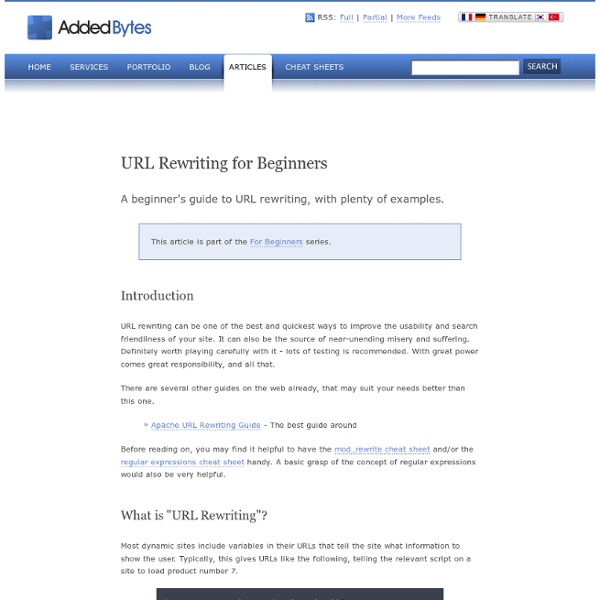Using .htaccess to add trailing slashes to all URIs or URLs
Apache's Rewrite Module allows developers to define extensive URL Rewriting and Redirecting Conditions & Rules, one of which could be to add trailing slashes to Representational State Transfer (RESTful) URLs. RESTful URLs are Uniform Resource Indicators (URIs) that are more user- and SEO-friendly than standard GET-based URIs. For example (GET vs.
'MySQLi' for Beginners
Introduction Nearly every site that you visit nowadays has some sort of database storage in place, many sites opt to use MySQL databases when using PHP. However, many people haven't yet taken the step to interacting with databases properly in PHP. Here we guide you through what you should be doing - using PHP's MySQLi class - with a hat-tip to the one way that you definitely shouldn't be doing it. The Wrong Way If you're using a function called mysql_connect() or mysql_query() you really need to take note and change what you're doing.
Crazy Advanced Mod_Rewrite Tutorial
Are you an advanced mod_rewrite expert or guru? This article is for YOU too! Just make sure to read all the way to the bottom..
How to: find ANYTHING on the Internet
Photo by Dullhunk Tips, tricks and resources to help you find that digital needle in the huge cyber-haystack. Learning to navigate the World Wide Web effectively is an important skill, and there are lots of different ways for you to find the information you are looking for.
Le module Apache mod_rewrite
mod_rewrite provides a way to modify incoming URL requests, dynamically, based on regular expression rules. This allows you to map arbitrary URLs onto your internal URL structure in any way you like. It supports an unlimited number of rules and an unlimited number of attached rule conditions for each rule to provide a really flexible and powerful URL manipulation mechanism. The URL manipulations can depend on various tests: server variables, environment variables, HTTP headers, time stamps, external database lookups, and various other external programs or handlers, can be used to achieve granular URL matching. Rewrite rules can operate on the full URLs, including the path-info and query string portions, and may be used in per-server context (httpd.conf), per-virtualhost context (<VirtualHost> blocks), or per-directory context (.htaccess files and <Directory> blocks).
Unicode Transformation Formats
The ISO 10646 Universal Character Set (UCS, Unicode) is a coded character set with more than 40'000 defined elements. It is expected that this cardinality will grow to more than 100'000 soon, through additional definitions for characters that do not yet have a coding, so that all the world's characters will be represented in Unicode. But how can you represent more than 2^8 = 256 characters with 8bit bytes? This chapter explains and discusses the concepts of coded character sets versus their encoding schemes as well as the various Unicode representation schemes along with their implementation level on Unix: most prominently UTF-8 beside its precursors EUC and UTF-1 and its alternatives UCS-4, UTF-16, UTF-7,5, UTF-7, SCSU, HTML, and JAVA. Another fine web page describing these subjects is Jukka Korpela's tutorial on character code issues.
5 Awesome Learning Resources For Programmers (To help you and your kids to grow the geek neurons)
Happy New Year, this is my first post in 2012. I’ll be sharing few awesome learning resources I’ve bookmarked, and will be pointing out some specific computer/programming related courses I've found interesting from these resources. Also, thought about saving this blog post for my kids as well - instead of investing in these Child education schemes (though they are too small as of today, 2 years and 60 days respectively ). Anyway, personally my new year resolution is to see as much videos from this course collections (assuming I can find some free time in between my regular job && changing my babies diapers). 1 – Khan Academy
SEO Made Simple: A Step-by-Step Guide for 2020
Guess how many blog posts people publish each day. Any ideas? Well, WordPress users alone publish over 2 million posts every day. That comes out to 24 blog posts every second. That means that users published around 216 blog posts while you were reading these five sentences.
.htaccess tricks and tips.. part two: url rewriting with mod rewrite.
corz.org uses cookies to remember that you've seen this notice explaining that corz.org uses cookies, okay! <ifModule> more clever stuff here </ifModule> redirecting and rewriting "The great thing about mod_rewrite is it gives you all the configurability and flexibility of Sendmail.
Sass vs. LESS
"Which CSS preprocessor language should I choose?" is a hot topic lately. I've been asked in person several times and an online debate has been popping up every few days it seems. It's nice that the conversation has largely turned from whether or not preprocessing is a good idea to which one language is best. Let's do this thing. Really short answer: Sass



